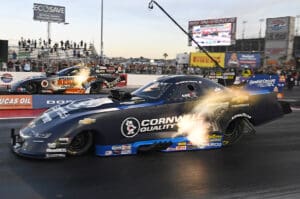 The last 25 years, NHRA’s Pro Stock Motorcycle class has experienced quite an evolution.
The last 25 years, NHRA’s Pro Stock Motorcycle class has experienced quite an evolution.
In 1987, NHRA introduced the Pro Stock Motorcycle class as a professional category and that year the late Dave Schultz was the first world champion.
“They were racing Pro Stock Motorcycles before 1987, but it just didn’t get notoriety (because it wasn’t sanctioned by NHRA),” said Steve Johnson, who has been racing a Pro Stock Motorcycle since ‘87. “The thing that stands out to me about 1987 was Terry Vance was racing and the motorcycles were so different. They were not nearly as fast and they were not nearly as sophisticated and technical. They were running eight seconds back then, and we just moved from using a motorcycle-style tire to a car tire. As the horsepower evolved we needed more traction.”
Pro Stock Motorcycle competitors will make their 2012 NHRA season debut Friday through Sunday at the Gatornationals in Gainesville, Fla.
Reigning world champion Eddie Krawiec also is the defending champ at the Gatornationals. Krawiec, who also won a world title in 2008, pilots the Screamin’ Eagle Vance & Hines Harley-Davidson.

The last 25 years, NHRA’s Pro Stock Motorcycle class has experienced quite an evolution.
 In 1987, NHRA introduced the Pro Stock Motorcycle class as a professional category and that year the late Dave Schultz was the first world champion. – Auto ImageryIn 1987, NHRA introduced the Pro Stock Motorcycle class as a professional category and that year the late Dave Schultz was the first world champion.
In 1987, NHRA introduced the Pro Stock Motorcycle class as a professional category and that year the late Dave Schultz was the first world champion. – Auto ImageryIn 1987, NHRA introduced the Pro Stock Motorcycle class as a professional category and that year the late Dave Schultz was the first world champion.
“They were racing Pro Stock Motorcycles before 1987, but it just didn’t get notoriety (because it wasn’t sanctioned by NHRA),” said Steve Johnson, who has been racing a Pro Stock Motorcycle since ‘87. “The thing that stands out to me about 1987 was Terry Vance was racing and the motorcycles were so different. They were not nearly as fast and they were not nearly as sophisticated and technical. They were running eight seconds back then, and we just moved from using a motorcycle-style tire to a car tire. As the horsepower evolved we needed more traction.”
Pro Stock Motorcycle competitors will make their 2012 NHRA season debut Friday through Sunday at the Gatornationals in Gainesville, Fla.
Reigning world champion Eddie Krawiec also is the defending champ at the Gatornationals. Krawiec, who also won a world title in 2008, pilots the Screamin’ Eagle Vance & Hines Harley-Davidson.
Last March at Gainesville, Hector Arana Sr. set NHRA’s Pro Stock Motorcycle elapsed time record at 6.777 seconds. Krawiec established NHRA’s Pro Stock Motorcycle speed record a year ago in Gainesville at 199.26 mph.
“I remember the first time letting the clutch out with a car tire on the bike versus a motorcycle tire,” said Johnson, who has five career NHRA national event wins. “With a motorcycle tire, you could drive the bike wherever you wanted to on the track. The car tire was more or less you were going to aim an arrow or a bullet and you were going to try and maneuver it through the track, but you didn’t have nearly the steering ability as you did with a motorcycle tire.”
These days, Pro Stock Motorcycle riders are using a 10-inch wide Mickey Thompson slick as the back tire on their bikes.
“That has been the norm just about forever,” Johnson said. “When we started (before the class was sanctioned by NHRA), we were using an eight inch wide motorcycle tire, but they were a really low profile tire and it didn’t have near the footprint a car tire has. Back then, we had 200 horsepower and now we have probably 350 to 375 horsepower. There were people who ran motorcycle tires (in 1987), but if you were serious you were going to run a car tire.”
According to NHRA records, riders began competing in the Pro Stock Motorcycle class in 1982 it just wasn’t sanctioned as a professional class by the sanctioning body until 1987.
Vance was the star of the class from 1982-86 winning the majority of the events, including the first two which were contested in 1982 at Gainesville and Atlanta. Vance now is the president of the Vance & Hines Performance shop based in Santa Fe Springs, Calif. Vance won 24 career Pro Stock Motorcycle national events.
Back in ’87, the NHRA Pro Stock Motorcycle class had a seven-race series and it is has been expanded to 16 races for the last several years.
“One of my favorite stories from where we were as a Pro Stock Motorcycle class is Terry Vance won a race (back when the class was starting up), and they gave him Don Garlits’ trophy to take the picture (in the winner’s circle),” Johnson said. “Then, they took it back and gave it back to Don. They just didn’t have a trophy for Terry.”
Another key figure in the transformation of NHRA’s Pro Stock Motorcycle class is team owner George Bryce.
From 1990-2002, Bryce’s Pro Stock Motorcycle riders for Star Racing won six NHRA championships in 1990, 1992, 1995, 2000, 2001, and 2002. Also in those 13 seasons, Bryce’s riders finished no worse than second in the points standings. Bryce’s team has won 78 NHRA national events with 11 different riders.
“I’m real proud the Pro Stock Motorcycle class is still going after 25 years,” Bryce said. “I remember when we went to Indy to race the Pro Stock bikes and we sat in the staging lanes all day with our leathers and helmets on, waiting for our turn at the track. Then in 1989, Winston and NHRA got together and said you know we need to clean this up and make this into a real pro category. So when John Force ran and Warren Johnson ran, the bikes would run. We knew when we were going to run and we ended up fitting into an official schedule that NHRA stuck with and that really helped our category grow.”
Bryce, who also won NHRA’s Pro Stock Motorcycle event in Dallas in ’87, took a moment to reflect on how far the category has come since then.
“The category has had incredible growth,” Bryce said. “When I won at Dallas, Terry Vance set the national record at 7.99 (seconds). I won the race with 8.0s. We watched John Myers bump the record to 7.90s, 7.80s, and 7.60s. Then, he and Dave Schultz took turns going 7.60s, 7.50s and 7.40s, and then Angelle (Sampey) jumped in and started bumping the record into the 7.30s and 7.20s. Matt Smith jumped in there with her and they took turns bumping the record all the way down to 7 flat. Then, the Vance & Hines Harleys went 6.90s for the first time. Now, Hector Arana (Sr.) went 6.77 last year at Gainesville. The motorcycles are almost going a second and half faster than they used to go.”

“By paying for the TV camera that guaranteed us TV coverage, and we started creating a fan base,” Bryce said. “The rivalry between the late great Dave Schultz and the late great John Myers ended up jacking the category’s popularity up pretty good. Then of course in 1996 we introduced Angelle Sampey (as Bryce’s team rider) and she ended up winning three championships with us and that was really a big boost for our category.”
Sampey won Pro Stock Motorcycle world championships in 2000, 2001 and 2002. Legendary Shirley Muldowney is the only other female NHRA pro series world champion, winning Top Fuel titles in 1977, 1980 and 1982. Sampey also holds the most NHRA victories, 41, for a female.
“I have watched the category evolve from the popularity of the Harley-Davidson and the V-Twin versus the four cylinders and corporate America getting behind the class,” Bryce said. “You have big companies like Harley-Davidson, Geico, U.S. Army and R.J. Reynolds Tobacco Company that were putting marketing dollars into the category helped our category grow into the popularity it has today.”
Johnson, meanwhile, has a hard time believing how far the Pro Stock Motorcycle class has come.
“I never thought the class would be to this point now,” Johnson said. “We started out with a handful of races and now we have a competitive series with Harleys, Buells and Suzukis and we love being the little brothers of the Pro Stock cars because they are so competitive. The real deal is we are so fortunate to be a part of the Full Throttle Series. We are able to showcase our category in front of 100,000 fans at every race and be on TV as part of the professional series. For me, that’s the greatest accomplishment that our class has. When, we all started (in the Pro Stock Motorcycle class) none of us had tractor trailers. We had box vans and chaparral trailers. Everybody worked on their bikes inside the box van or inside the trailer. Now, you either have a tractor trailer or a huge toterhome, and everybody works on their motorcycles outside of their tractor trailer. That engages the fans and I think that fits along with why we (the Pro Stock Motorcycle class) have survived. That’s what drag racing is all about, you get to come into the pits. You can’t come into our locker room if our locker room is shut and we as a group knew it was important to change that model. With us racing in the NHRA, we knew we had to park our bikes outside and work on them outside so people could see the bikes.”
Although Bryce has had numerous shining moments in NHRA’s Pro Stock Motorcycle class, a few stand out more than others.
“One is bringing the first female champion to Pro Stock Motorcycle in Angelle (Sampey) and she became the winningest female in motorsports history,” Bryce said. “The other really big sense of accomplishment for me was working with S&S Cycle to bring the V-Twins to the market that would make them available to everyone. We introduced the S&S-powered V-Twin, which is called the Buells by everybody else, in 2004. Since then we have sold 68 of those engines. That was a really big step for our category because we brought in new people who were not coming because they didn’t want to race a Suzuki and that was really the only game in town until we introduced the Buells. Now we race American-made V-Twins and they are available to everybody. The third most important thing I’m proud of is bringing R.J. Reynolds Tobacco Company to be a major sponsor for a Pro Stock Motorcycle, they were with me for four years and sponsored Angelle. I’m also proud of the fact I have been able to bring new talent and new stars to the sport.”
Bryce has two newcomers riding for his Pro Stock motorcycle team in John Hall and Scotty Pollacheck. Hall and Pollacheck are competing in full seasons in 2012.
Johnson also has relished being part of NHRA’s Pro Stock Motorcycle class.
“Just being involved from the business side is a huge sense of pride for me,” Johnson said. “At the end of the day, it is really the job of the teams to go out and win and that’s what you want to do, but I think before you have a place that you can win, you have to make sure the fans are happy. And, to put on a competitive show with motorcycles is the ultimate way to keep the fans happy and have them intrigued with our class.”
Johnson also believes the Pro Stock Motorcycle class is something that relates to the common fan and lures in prospective competitors.
“When you see motorcycles, they are probably the most economical form of transportation going,” Johnson said. “They are in our mainstream and in our society so much and to be able to take that motorcycle to a dragstrip and race it professionally and do it for an economical amount of money and be involved with a professional series is great. I do not know of another series that you can race in like this. A lot of the new drivers we have coming into the class could not go out and get in a Pro Stock car for this kind of money. They could not get in a Top Fuel or Funny Car for this type of money, but they can get involved in a Pro Stock Motorcycle program and be part of a professional series and have a marketing plan and try to create a career and a business. That’s a really important part of how the evolution of our class started, and how it has continued and how it will go forward.”
 Steve Johnson believes the Pro Stock Motorcycle class is something that relates to the common fan and lures in prospective competitors.Bryce, meanwhile, understands the reality that many of NHRA’s Pro Stock Motorcycle riders aren’t making a living by competing in this category.
Steve Johnson believes the Pro Stock Motorcycle class is something that relates to the common fan and lures in prospective competitors.Bryce, meanwhile, understands the reality that many of NHRA’s Pro Stock Motorcycle riders aren’t making a living by competing in this category.
“We have a lot of underfunded Pro Stock Motorcycle teams and we do not really have very many professional teams,” Bryce said. “I would say that 90 percent of the teams have jobs they have to report to on Monday morning. The Pro Stock Motorcycle category sometimes is disappointed that it is not included in everything that is considered professional (by NHRA). But in reality, we are semi pros because we only go to some of the races. We are semi-committed to the full (NHRA) circuit, therefore we will only semi considered professionals. We need to relax on the fact that we are not full-time pros. We are full-time employees of other companies and other jobs and we race on a semi-pro level.”
Although many skeptics probably thought NHRA’s Pro Stock Motorcycle class would never last this long, Bryce is hoping the category is still going strong 25 years from now.
“What we have to do is find a way to make it available and affordable to more people,” Bryce said. “We have to find a way to make it more popular with personalities instead of it just being stymied to just machines. We need personalities like NASCAR has. A lot of people do not even care what brand they race, they just care about the driver. There is a lot of team loyalty, a lot of driver loyalty and a lot of brand loyalty and we need to find a way to capitalize on that better. That is going to be done by the teams individually, the drivers individually and of course NHRA’s marketing. It is going to have to be a collaborate effort by all us to make that come true.”
Johnson shared some of the same ideas as Bryce about the future of the Pro Stock Motorcycle class.
“Before we look at the Pro Stock Motorcycle class getting to year 50, we just need to chip away at five-year plans,” Johnson said. “The five-year plan is to be able to convey the opportunity our class has. Simply put, motorsports is a business and it is one of many business opportunities that promote products. So, if it cost $2 to $5 million to race a Top Fuel car, they (a business) can get involved in Pro Stock Motorcycle for $250,000 to $500,000. It’s a great way to get involved from a marketing standpoint in motorsports.”






































